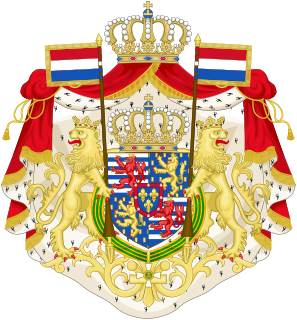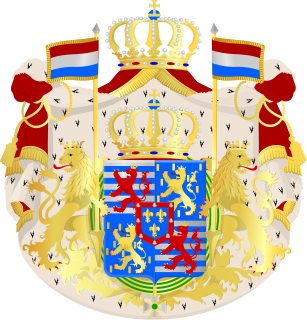Morganatic marriage, sometimes called a left-handed marriage, is a marriage between people of unequal social rank, which in the context of royalty prevents the husband's titles and privileges being passed on to the wife and/or any children born of the marriage.
Primogeniture ( ) is the right, by law or custom, of the firstborn legitimate child to inherit the parent's entire or main estate in preference to shared inheritance among all or some children, any illegitimate child or any collateral relative. In most contexts it means the inheritance of the firstborn son ; it can also mean by the firstborn daughter.
The Grand Ducal Family of Luxembourg constitutes the House of Luxembourg-Nassau, headed by the sovereign Grand Duke, and in which the throne of the grand duchy is hereditary. It consists of heirs and descendants of the House of Nassau-Weilburg, whose sovereign territories passed cognatically from the House of Nassau to a cadet branch of the House of Bourbon-Parma, itself a branch of the Spanish Royal House which is agnatically a cadet branch of the House of Capet that originated in France. This is descended from the Capetian dynasty – itself a derivative dynasty from the Robertians.

The grand duke of Luxembourg is the monarchical head of state of Luxembourg. Luxembourg has been a grand duchy since 15 March 1815, when it was created from territory of the former Duchy of Luxembourg. It was in personal union with the United Kingdom of the Netherlands until 1890 under the House of Orange-Nassau. Luxembourg is the world's only sovereign grand duchy and since 1815, there have been nine monarchs, including the incumbent, Henri.

Jean was the Grand Duke of Luxembourg from 1964 until his abdication in 2000. He was the first Grand Duke of Luxembourg of French agnatic descent.

William IV reigned as the Grand Duke of Luxembourg from 17 November 1905 until his death. He succeeded his father, Adolphe.

The Danish royal family is the dynastic family of the monarch. All members of the Danish royal family except Queen Margrethe II hold the title of Prince/Princess of Denmark. Dynastic children of the monarch and of the heir apparent are accorded the style of His/Her Royal Highness, while other members of the dynasty are addressed as His/Her Highness. The Queen is styled Her Majesty.
In history and heraldry, a cadet branch consists of the male-line descendants of a monarch or patriarch's younger sons (cadets). In the ruling dynasties and noble families of much of Europe and Asia, the family's major assets—realm, titles, fiefs, property and income—have historically been passed from a father to his firstborn son in what is known as primogeniture; younger sons—cadets—inherited less wealth and authority to pass to future generations of descendants.
The Nassau Family Pact was a mutual pact of inheritance and succession made in 1783 by princes of the old European noble and sovereign family of Nassau. It confirmed that Salic Law was to operate in favor of all the agnatic lines of the family, specifically the two senior surviving lines which had originated in the Middle Ages, the Walramian and the Ottonian. The pact chiefly provided that in case of one of these lines becoming extinct, the other would succeed in its hereditary Nassau lands.

Leopold succeeded in 1830 as the Grand Duke of Baden, reigning until his death in 1852.

Princess Alexandra of Luxembourg is the fourth child and only daughter of Grand Duke Henri and Grand Duchess Maria Teresa. She has three older brothers: Hereditary Grand Duke Guillaume, Prince Félix, and Prince Louis, and one younger: Prince Sébastien.

The House of Nassau is a diversified aristocratic dynasty in Europe. It is named after the lordship associated with Nassau Castle, located in present-day Nassau, Rhineland-Palatinate, Germany. The lords of Nassau were originally titled "Count of Nassau", then elevated to the princely class as "Princely Counts". Early on they divided into two main branches: the elder (Walramian) branch, that gave rise to the German Emperor Adolf, and the younger (Ottonian) branch, that gave rise to the Princes of Orange and the monarchs of the Netherlands.

Princess Margaretha of Liechtenstein is the fourth child and second and youngest daughter of Grand Duke Jean of Luxembourg and Princess Joséphine-Charlotte of Belgium. As the sister of Grand Duke Henri of Luxembourg and the sister-in-law of Prince Hans-Adam II of Liechtenstein, she is a princess of two current realms and a member of the Luxembourg and Liechtenstein reigning dynasties.

Count of Merenberg is the title bestowed in 1868 by the reigning Prince of Waldeck and Pyrmont, George Victor, upon the morganatic wife and male-line descendants of Prince Nikolaus Wilhelm of Nassau (1832-1905), who married Natalia Alexandrovna Pushkina (1836-1913), former wife of Russian General Mikhail Leontievich von Dubelt.

Wilhelm was joint sovereign Duke of Nassau, along with his cousin Frederick Augustus, reigning from 1816 until 1839. He was also sovereign Prince of Nassau-Weilburg from 1816 until its incorporation into the duchy of Nassau.

Amsberg is the name of a German noble family from Mecklenburg. A great-grandson of a blacksmith, parish pastor August Amsberg (1747–1820) started calling himself "von Amsberg" in 1795 and the family's right to use this name was confirmed by the Grand Duke of Mecklenburg-Schwerin in 1891. By this permission to use a noble privilege, the family effectively became part of the untitled lower nobility of the Grand Duchy of Mecklenburg-Schwerin. The present King of the Netherlands, Willem-Alexander is an agnatic member of this family.

Clotilde, Countess von Merenberg, is a German psychiatrist and the last patrilineal descendant of the House of Nassau. She is a descendant of Emperor Alexander II of Russia and of the Russian poet Alexander Pushkin.














